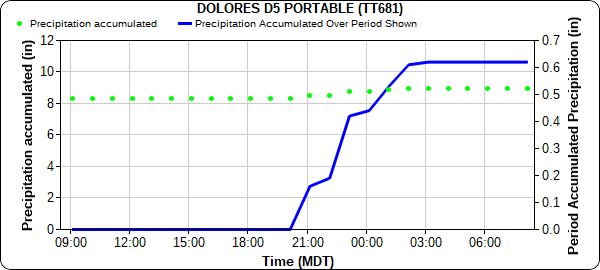Issue Date: Monday, September 20th, 2021
Issue Time: 10:40 AM MDT
Summary:
A cold-frontal passage and associated trough entered the state from the northwest late Sunday evening, drastically changing the weather pattern for Colorado. Thunderstorms began to form in the Northwest Slope and Northern Mountains ahead of the front in the early evening, and included some high, gusty winds – a 46-mph gust was reported in Hayden. With the eastward progression of the front, showers became more widespread over the Northern, Central, and Front Range Mountains but lacked the necessary instability for heavy rainfall due to the timing of the passage over the evening hours into the night. Temperatures were also lowered enough from the frontal passage for precipitation to fall as snow at high elevations, which limits runoff.
What's this? Can it be? Yes, the latest system brought a little bit of snow over the northern peaks overnight. This image is from Rabbit Ears Pass @ColoradoDOT. It's not much but we will take it! Enjoy the cool, fall temperatures today! #COwx #UTwx pic.twitter.com/HFrpCcVQhv
— NWS Grand Junction (@NWSGJT) September 20, 2021
A CoCoRaHS observer in Clark reported 1.2 inches of snow on the ground after the front and 0.81 inches of liquid once the snow/icy mix was melted down. The Steamboat Springs area received between 0.50-0.72 inches of liquid precipitation. An observer in Parshall recorded 0.71 inches yesterday, with the following remark about the nature of the precipitation:
Precipitation was a mix of rain, graupel, and snow accompanied by wind and a little thunder. We don’t see this much precipitation very often from one storm. In the areas where snow accumulated I measured 0.3″. Overall however, it was a trace due to bare areas.
Rainfall totals decreased as the front continued to progress eastward over the Urban Corridor and Northeast Plains. A secondary boundary ahead of the trough also formed on the Northeast Plains overnight, kicking off some light precipitation but nothing notable. Rainfall totals across Fort Collins range from Trace – 0.16 inches.
No flooding was reported on Sunday. For rainfall estimates in your area, check out the State Precipitation Map below.
The Pueblo radar is currently being upgraded and is offline for the next few weeks, so radar-based precipitation estimates for Southeast Colorado are having to rely on further radars in Denver, New Mexico, Texas, and Kansas. This will result in precipitation being underestimated for this region. More information the radar upgrade can be found here.
Click Here For Map Overview




